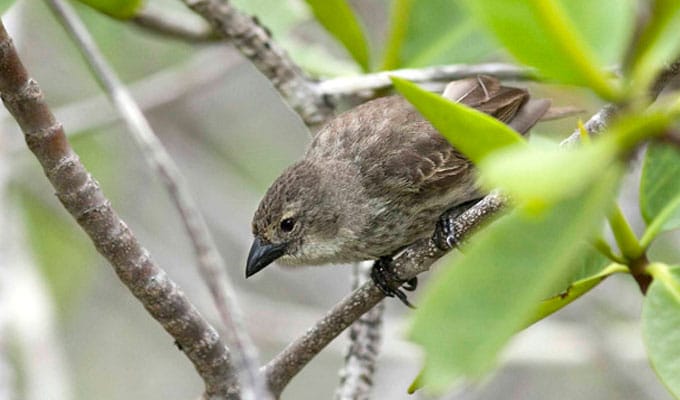As your vessel approaches the Galapagos National Park, notice that many of the coastal shores are lined with small trees, supported by long crawling roots that seem to grow right out of the salty ocean water. These trees are known as mangroves, which are renowned for their ability to grow in near-permanent or permanent bodies of water and/or extremely high levels of salt (thriving in water 100 times saltier than most trees can tolerate). Galapagos mangroves are particularly remarkable due to their age. These trees grow from the volcanic floor with limited nutrients and therefore grow very slowly; any developed mangrove habitat in the islands is most likely thousands of years old. In fact, thanks to their remarkable development and richness, the mangrove forests on South Isabela were RAMSAR certified in 2002.
TALK TO A DESTINATION EXPERT

Diego Zapata

Rosa Mena

Sandy Lara

Diego Zapata

Rosa Mena

Sandy Lara
Dealing with the salty water
Galapagos mangroves are salt-tolerant trees that grow where water meets land, and thus are typically found along coastlines. In order to withstand these extremely stressful conditions, mangroves have developed a series of brilliant adaptions. One of their most notable adaptations is their root system, which typically grows above the land like stilts in twisted looping formations. This is a technique that allows the trees to absorb oxygen through the pores in their roots, as the oxygen in the water or mud in which they live is either minimal or difficult to absorb. Other mangroves, such as the black mangrove, live on higher land where water levels are lower. Black mangroves instead have tentacle-like roots (pneumatophores) covered in pores that grow up from the surface to breathe oxygen from the air.
The trees also have a variety of techniques to filter the extremely high levels of salt in their environment; some species use a mixture of techniques while others just use one. Some Galapagos mangroves (i.e. red mangroves) are able to filter up to 97% of the salt from the water where they grow. Their highly impermeable roots act as the perfect filtration system, stopping the majority of salt from ever entering the tree. On the other hand, some mangroves concentrate excess salt in old leaves, which they then shed. The mangroves’ generally vertical branches also assist in this process, acting as aerating organs to filter salt so that the water that reaches the leaves is fresh. Still, other mangroves, such as the white mangrove, secrete salt directly from the plant- they have two salt glands on each leaf base.
Visitors to the Galapagos will also notice that the mangroves have very waxy or even fuzzy leaves, which are specifically developed to reduce the amount of water that evaporates from the leaves and conserve the precious freshwater they have acquired. The leaves may also have a succulent form, enabling them to store more water in their fleshy tissue.
Galapagos mangroves

There are four types of Galapagos mangroves: the red mangrove, the black mangrove, the white mangrove, and button mangroves. The black mangrove has the highest salt-tolerant leaves of any other species in the Galapagos and even has special salt-extracting glands. This type of mangrove can be recognized by its short aerial roots, as well as the small tentacle roots that grow vertically up from the soil and surround the tree. Red mangroves are more common in the Galapagos and can be more easily recognized thanks to the reddish wood that covers them. They are common around the low tide zone. This species is used all over the world as a source of charcoal. White mangroves have delicate white flowers, as well as stilted roots and pneumatophores. The last species, the buttonwood mangrove, is not a true mangrove, but it is frequently found around mangroves that grow at higher elevations (such as the black mangrove) and also has an aboveground root system.
Why are they important?
Mangroves are not only special because of their unique roots and filtering ability, but they play a critical role in many coastal systems, adding to the biological diversity in the Galapagos. Mangrove forests host a rich concentration of nutrients, as well as plankton, thus making them important breeding grounds for fish, birds, and other invertebrates, including turtles, penguins, flamingos, rays and even sharks. The roots also protect animals from large predators and waves, reducing the strength of the latter by up to 75%.

Javier Garcia

Eduardo Silva

Carolina Escobar
START PLANNING YOUR TRIP

Javier Garcia

Eduardo Silva

Carolina Escobar
Get in touch for more
CONTACT US
Great opportunities to see mangroves and learn more about them are Western Galapagos Islands on the Galapagos cruise Santa Cruz II, with excellent opportunities in Fernandina Island, Tortuga Bay, and Northern Floreana. Also extraordinary to learn and see all four species of mangroves and learn about them is the Finch Bay Galapagos Hotel: its gardens are predominantly buttonwood mangroves (part of a long-term reforestation plan), while the other species can be seen only a few feet away framing a lovely beach. Short walk west of the hotel leads to a calm bay with lofty mangroves, where every morning and evening herons flock to and from their roosting areas.


